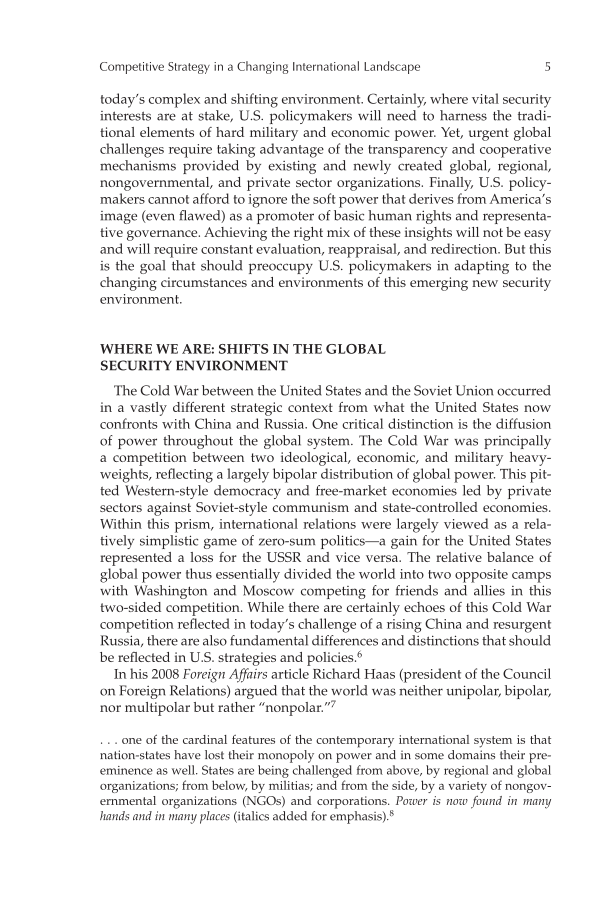Competitive Strategy in a Changing International Landscape 5 today’s complex and shifting environment. Certainly, where vital security interests are at stake, U.S. policymakers will need to harness the tradi- tional elements of hard military and economic power. Yet, urgent global challenges require taking advantage of the transparency and cooperative mechanisms provided by existing and newly created global, regional, nongovernmental, and private sector organizations. Finally, U.S. policy- makers cannot afford to ignore the soft power that derives from America’s image (even flawed) as a promoter of basic human rights and representa- tive governance. Achieving the right mix of these insights will not be easy and will require constant evaluation, reappraisal, and redirection. But this is the goal that should preoccupy U.S. policymakers in adapting to the changing circumstances and environments of this emerging new security environment. WHERE WE ARE: SHIFTS IN THE GLOBAL SECURITY ENVIRONMENT The Cold War between the United States and the Soviet Union occurred in a vastly different strategic context from what the United States now confronts with China and Russia. One critical distinction is the diffusion of power throughout the global system. The Cold War was principally a competition between two ideological, economic, and military heavy- weights, reflecting a largely bipolar distribution of global power. This pit- ted Western-style democracy and free-market economies led by private sectors against Soviet-style communism and state-controlled economies. Within this prism, international relations were largely viewed as a rela- tively simplistic game of zero-sum politics—a gain for the United States represented a loss for the USSR and vice versa. The relative balance of global power thus essentially divided the world into two opposite camps with Washington and Moscow competing for friends and allies in this two-sided competition. While there are certainly echoes of this Cold War competition reflected in today’s challenge of a rising China and resurgent Russia, there are also fundamental differences and distinctions that should be reflected in U.S. strategies and policies.6 In his 2008 Foreign Affairs article Richard Haas (president of the Council on Foreign Relations) argued that the world was neither unipolar, bipolar, nor multipolar but rather “nonpolar.”7 . . . one of the cardinal features of the contemporary international system is that nation-states have lost their monopoly on power and in some domains their pre- eminence as well. States are being challenged from above, by regional and global organizations from below, by militias and from the side, by a variety of nongov- ernmental organizations (NGOs) and corporations. Power is now found in many hands and in many places (italics added for emphasis).8
Document Details My Account Print multiple pages
Print
You have printed 0 times in the last 24 hours.
Your print count will reset on at .
You may print 0 more time(s) before then.
You may print a maximum of 0 pages at a time.











































































































































































































































































































































































